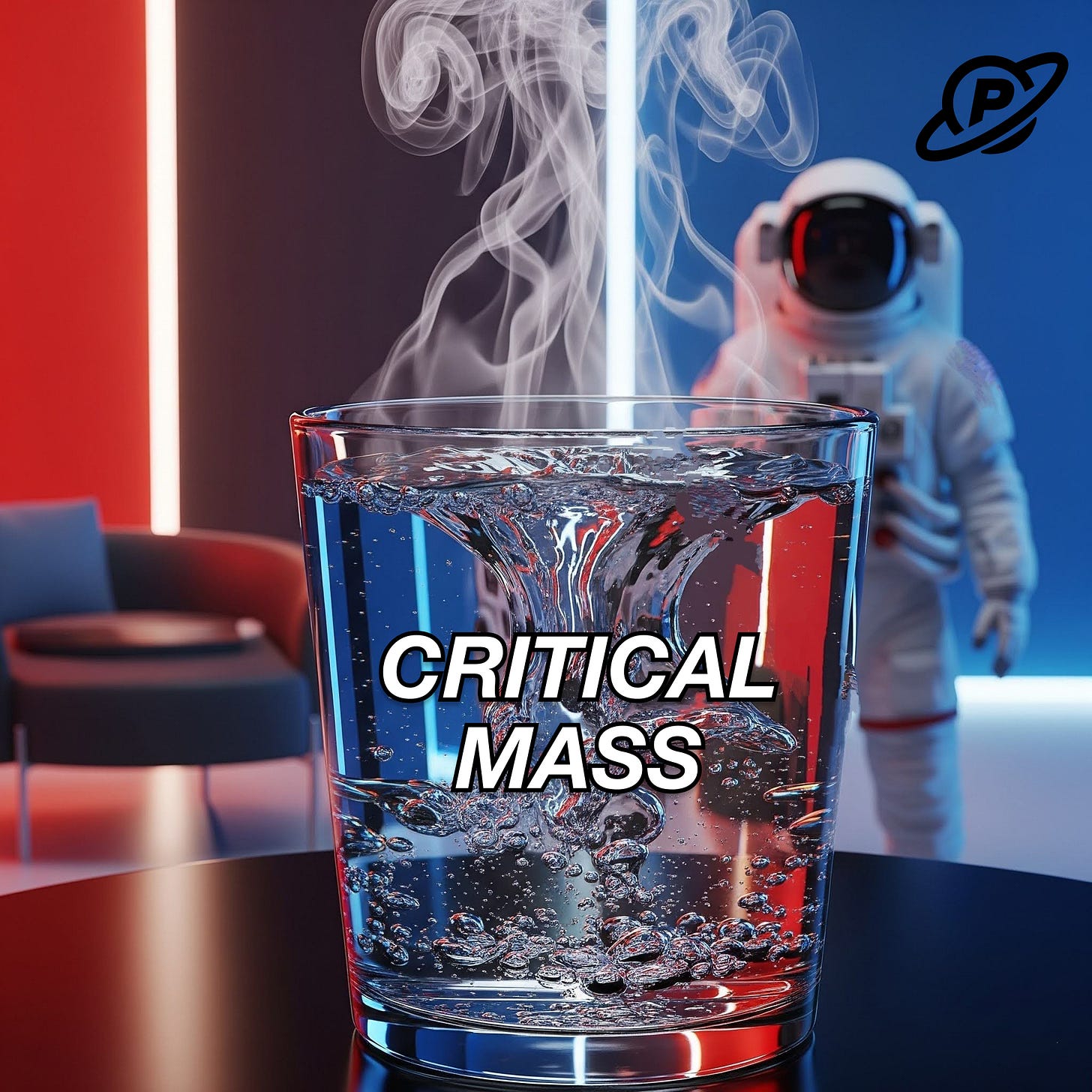Critical Mass - Mental Model
Buying my first pair of proper running shoes was one of the best decisions of my life.
Just five years ago, I hated running — barely surviving 5 kilometres and loudly cursing the entire activity as boring and pointless.
But something changed. After spending a few months in the Polish mountains, where I cycled every day, I returned to the city and missed that physical activity. I didn’t have a bike with me, so I bought my first proper pair of running shoes.
At first, I had the worst technique and my knees hurt. But slowly, with advice from my friend, I reached a point where the habit started to keep going on its own. Now it's difficult for me to imagine not running at least a few times a week.
This is what we call critical mass — the moment when things start to move by themselves. The effort that once felt difficult begins to get easier.
From personal habits to product adoption, this mental model serves as a useful way to think about lasting change.
What is Critical Mass?
Critical mass is a concept from nuclear fission reactions, referring to the minimum amount of material required to sustain a chain reaction.
The simplest example is water reaching its boiling point: it remains liquid at 99°C but transforms into steam at 100°C (at sea level).
This is a threshold moment — all the energy slowly added to heat the water leads to a dramatic change. However, the gradual build-up of energy needed to reach that point is equally important and shouldn't be dismissed.
As a mental model, we can use it to understand how we achieve success, make changes, or win market share. It gives us valuable insights when we look at different situations.
Applications
Market Share
Would it make sense to use email if other people didn't use it?
We need critical mass to adopt any technology — other people must use it too if we want to collaborate. A critical mass of users is needed for an innovation to take off.
Examples:
Facebook began as a college-only platform but grew to dominate social media once it reached a critical mass of users — we opened accounts because everybody was there.
PayPal aimed for a critical mass of 1 million users, they implemented a referral program of $10 for joining, and $10 for every referred friend, which led to exponential growth.
Software Development
Critical mass also explains why some programming languages and frameworks succeed.
A programming language needs enough developers using it before it becomes stable to use. Once it reaches critical mass, more developers learn it, more companies adopt it, and more resources become available — creating a self-reinforcing loop.
Examples:
JavaScript started as a simple browser scripting language but reached critical mass when Node.js enabled server-side development.
Python became a go-to language for data science because of the critical mass of tools and libraries.
Overton Window
Critical mass doesn't just apply to technology and habits but also shapes how society accepts new ideas.
The Overton Window is the shifting boundary of acceptable ideas, where what was once considered radical becomes mainstream as it gains critical mass. Once a critical threshold is reached, society begins to embrace the change, making it the new norm.
Examples:
Women’s Right to Vote: The idea of women voting was once considered radical, but over time, advocacy and societal shifts led to its acceptance and legalization. It’s hard to believe it wasn’t always like that.
Climate Change Awareness: First unpopular, then climate change has gained critical mass in global discourse, influencing policy and public behaviour.
Building Long-Term Habits
Research shows that if you can maintain a habit for around 66 days, it's likely to become permanent.
I struggled to build the critical mass needed to become a runner for more than 9 months. It all changed thanks to the running watch, fixed training plan and goal to break 50 minutes for my first 10k race.
Having a pre-prepared training plan which I must follow to reach my goal was the most important factor.
Habit formation could be an entire article by itself. It depends on our commitment, how habits connect to our identity, and how much friction we remove to pursue them.
Making Change inside Organisation
Just like in personal habits, the same principle of critical mass applies to organisational change, where "the mass" builds as more individuals adopt new practices.
One of the biggest changes I had to implement was with how the company leadership structure was built:
ADKAR framework (Awareness, Desire, Knowledge, Ability, Reinforcement) is built around reaching critical mass in mind. The framework puts effort into identifying early adopters who will show examples to others, to help with building that critical mass. All its steps aim to build enough energy so that change is reinforced until it sustains itself. Reinforcement was an important reminder in the process.
Assessing Success — The Misconception
We tend to perceive "winners" we observe as overnight success in their craft.
The reality is that they put in hard work to build critical mass that leads to success, combined with some luck.
So when your progress feels slow, remember you're not failing — you're still heating the water.
Summary
When critical mass is reached, everything changes dramatically — products take off, habits stick, and ideas spread.
Just like my running journey, your breakthrough might be closer than you think.
Every day you show up, energy is added to the system. Keep adding energy long enough, and you will get there.
I wish you luck in reaching critical mass, wherever you want it.
Thanks for reading!
— Michał
P.S. Running is the most portable activity you can do. You can run almost anywhere in the world, regardless of the weather conditions. It’s the best sport that we, as a species, have literally evolved to enjoy. (I’m addicted and biased now — drop me a line if you need convincing to start running.)
Post Notes
Supporting Mental Models
Discover Weekly — Shoutouts
Articles that might help you explore new perspectives, which I’ve read recently:
How to Become an AI Engineer by
Fluid Intelligence vs. Crystallized Intelligence by
The software engineering "squeeze" by
.







In theory, we all know that success doesn't happen overnight (in most cases), but in reality, we usually forget about this principle. It was good to be reminded of it today - highly needed. Thank you!
Highly interesting! The critical mass mental model seems similar to the snowball effect. You never know when the breakthrough will happen, but the more energy we add, the more chances we'll have.
Thanks for the shout-out!